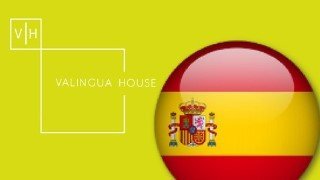Valingua house Unit 4 (Learn Spanish)
Valingua House is a simple and effective method for language learning, suitable for both private classes and large groups. It focuses on peer learning and introduces vocabulary needed for social interactions. The method works for students of different levels and ages, providing vocabulary not typically taught in schools. With regular assessments and opportunities for speaking and listening practice, Valingua House maximizes language retention. This course is designed for beginner or intermediate Spanish speakers.
What you’ll learn
- Students will be able to have a conversation with someone for about an hour and 30 minutes in Spanish.
Introduction
What is Valingua house?
Valingua house is a simple method to maximise language learning. This simple format can be translated into any language and this can be used for private classes or for a class of 200 people or more.
How can it be used for a class of so many people and still be effective?
The reason it can be used in a class for so many people is because the method interacts with our normal social behaviour. Peer learning is key to this method and by starting with the very basics of the language, you are introduced to the vocabulary most needed to get by socially in a different language. This then expands encouraging you to have a spontaneous conversation perhaps something completely different from the vocabulary taught.
Does this method work with a class of different levels and ages?
Yes. The method is for students with no skills or knowledge of the language, but after teaching with the Method in many classes with adults and children over the past three years, I have found that this could still be useful to students with a good knowledge and understanding of the language. I have had many group classes where one student has quite a good level of English for his age, and the level or age of the other student was inferior and the method can still be used.
This is because the students are being introduced to vocabulary that is not being taught in schools but is used widely in Native English speaking countries. So in every lesson there is about 7 – 12 words. Two or three of those words would be considered to be high level. For example a speaker with a fairly good level will probably know the words:
Hello, Good morning, Good night, how are you? Good and you?
But they probably don’t know the words:
I’m glad, the same to you, that’s amazing! That’s terrible!
All of these words mentioned above are in lesson 1 and 2 of the Tebbitt Method.
How does it work?
Valingua house is comprised into Units. Each unit is about 50 pages. 30 of these pages are the ‘Lessons’. Each lesson has a title which is a question. The first question is ‘What is your name?’. The Second is ‘How are you?’. The fourth ‘What do you like to do?’. The 15th is ‘Where have you been?’. Question 100 is ‘Where do you see yourself in five years’ time?. As you can see it gets more and more complex as you go on.
Every three lessons there is a dictation this is a simple way to practice and test the vocabulary you have learnt. There is between 7 and 12 words learnt in every lesson and 25 of them are placed in a list. The student must translate the words into their native language. Sometimes there will be several possible answers this is a good way for the students to understand that many words do not have a direct translation.
Also this gives a good indication to the teacher of how much this student has retained. The student keeps note of his score in the results page. This is a good way for the student or the teacher to look at his/her results page, go back to any previous dictation and test them on the vocabulary they didn’t get correct.
Every 15 lesson there is a level test. This is another dictation but with the most difficult vocabulary/expressions/phrases in the last 15 lessons.
Every 10 lessons there is a listening test. This is a long listening which is an extended conversation of all of the questions in the lessons. There is about 10 – 20 questions the students have to answer. They can listen to it 2 or 3 three times then again when going through the audio with the teacher correcting the test.
The other five or so pages are made up of exercises/tests about the verbs, expression or phrasal verbs they have learnt so far. There are about four or five games the teacher can incorporate into the classes if required. The index page at the front of the book happens to be a long list of questions. The students can go revise the method by just looking at the index and asking questions to their partner.
Assessment in Valingua house
At the end of each unit the student would have completed 30 lessons. As a result he would have done 10 dictations of 25 words each. That’s a total of 250 marks. This is the first sign of assessment, focused simply on being able to recall the meanings of words they have learnt.
Also they would have completed 3 listening tests and 2 level tests. The listening test is a long listening with 15-20 questions in each test. The two level tests in each unit is 50 of the most challenging words/phrases/expressions in the unit.
Last but not least, is the speaking and listening assessment that goes on throughout the method. The student is constantly talking to his class mates and depending on the size of the class he will have regular conversations with the student. If the teacher isn’t sure if the student understands something in the lesson, he can simply ask one of the questions available and talk to him. Testing and reinforcing. The Dictations, Listening tests, and level test also serve to test and reinforce the learning of the vocabulary.
What does the ‘Lesson’ pages contain?
The first thing you will see is the Title and number of the lesson. The title is a question. The second thing you will see is a table with about 7 – 12 words in separate columns. The first column is the words in the students native language. The second column is for the translated words in the desired language. The third column is blank. The students will hear the word in the desired language followed by the word in their native language followed again by the word in the desired language. Then there will be a pause, this is for the students to repeat the word out loud and write in the third column how they would spell it phonetically to better pronounce the word. There is no right or wrong answer. It’s whatever the student thinks it sounds like. For example: The Spanish word for Hello – Hola. If I was an English student studying Spanish I would put in the third column ‘ola’ because the Spanish don’t pronounce the ‘H’ at all and for me its sounds like ‘ola’ even though they write it with a H.
This repeats between 7 and 12 times giving you on average 10 new words, phrases, expressions and questions.
Below the table there is a short Example conversation. This will be a short normal conversation using the title question and the vocabulary learnt in the lesson and possibly before.
The student/students will hear the conversation in the audio, then they will read the conversation giving the teacher a chance to check pronunciation. Then the students will then translate the conversation into their own language. Sometimes a word cannot be translated literally and have to think a bit harder.
Not in every lesson but in most there will be a note. This is a little bit of advice or a grammar rule. The students will read this and the teacher will get his opportunity to explain something that the students want to be explained further. In the teacher’s book of Valingua house method you will see a note for the teacher saying for example: teach the difference between this, that, these, those. This is important to the Method. The teacher always needs to be evaluation and watching his class closely, if he sees a gap of knowledge, I want him/her, to fill the gap in his/her own style.
After the example conversation comes the ‘Second conversation’ This is a listening test longer than the example conversation but not as long and the ‘listening test’. The student should make notes about the audio because there will be around 2 to 6 questions the teacher will ask about the audio. This audio is based around the title question but is more complex and can have things from previous lessons.
The next stage is for the students to practice between themselves. Give the students between 3 to 5 minutes to have a conversation based around the title question. Try to practice it a few times with different people, encourage them to have a genuine conversation. Asking different questions to different people. The answers doesn’t have to be true, in fact it would be better if they practiced several different answers.
The final part of the Lesson page is the ‘Revision questions. These are between 2 – 5 questions to help the student have the longest possible conversation, and for the teacher to go around and test the students with their speaking and listening, correcting as always.
The teacher would then go back a few lessons and use the revision questions of previous lessons to revise a little before moving on to the next lesson or exercise.
How do I use/teach this method?
1 Students: Write in column 3 how they think the words should be spelt phonetically, and repeat the words out loud.
Teachers: Play audio, encourage students to say the word out
loud and repeat the word yourself to reinforce.
2 Students: Listen and read the example conversation. Then if chosen, read out loud and then the teacher will pick students to translate.
Teacher: Correct pronunciation and translation if necessary.
3 Teacher: If you feel that everybody has understood move on and play ‘conversation 2’ twice o three time if necessary. Then ask questions from the teacher’s book.
Students: Make notes about what you hear in the audio so that you can answer the question about conversation 2.
Teachers: If the students didn’t get many right or you feel they didn’t quite understand everything. Play audio again highlighting the answers.
4 Teacher: tell students to practice themselves. Go round groups correcting as you go.
Students: Practice with a partner/the person next to you. Try to make it a natural conversation, ask as many questions as you can.
5 Teacher: Stop the class and go round a few students or all students depending on numbers and have the conversation with them using the revision questions and correcting them if they make mistakes.
Student: Listen to the mistakes of others try not to make the same mistake. If you would like to be able to say something that came up in conversation ask the teacher.
Teacher: revise previous questions before moving on to the next lesson or exercise.
Who this course is for:
- Beginner or Intermediate Spanish speakers
User Reviews
Be the first to review “Valingua house Unit 4 (Learn Spanish)”
You must be logged in to post a review.







There are no reviews yet.